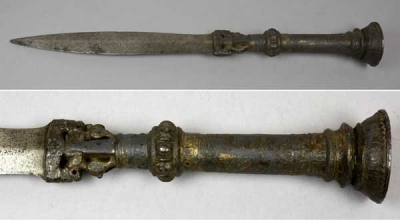Spear head (1884.24.243)
 BurmaSpear head from Myanmar (Burma), Asia. Part of the Pitt Rivers Museum Founding Collection. Given to the Museum in 1884.
BurmaSpear head from Myanmar (Burma), Asia. Part of the Pitt Rivers Museum Founding Collection. Given to the Museum in 1884.
Aside from a probable Burmese origin, there was little documentation accompanying this socketed spear-head when it came to the Museum as part of the Founding Collection in 1884. It has a double edge and appears to be of some form of iron, cast from a three-piece mould - the two halves, and a third fillet to form the socket.
Where the blade joins the ferrule there is an ornamental cast mounting with traces of gilding. It features two 'chinthei', non-identical Buddhist lions. These are the same as those that traditionally stand guard at the gates of temples and cities throughout the Buddhist world. In historical Burma, cities were occasionally laid out in the shape of a lion, with the fortified citadel as the lion's head. These implications of divine guardianship, strength and steadfastness suggest that the lions' presence on this spear would instil its carrier with confidence both in its abilities and in his own.





